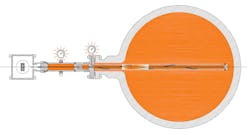Multipoint thermometers simultaneously measure temperature in multiple locations, either horizontally or vertically, within a process. Horizontal measurements could involve reading multiple temperature points at some level across a batch reactor or process vessel. A vertical temperature profile could be composed of top-to-bottom measurements in a tank. Environmental regulations and the need for better control propel increased use of such temperature profiling in many process applications.
For example, new environmental standards for low-sulfur fuels are driving the need for temperature profiling in the oil and gas and chemical industries. These standards and regulations require plants to reduce air pollution emissions, particularly NOx, and are leading to equipment retrofits and upgrades.
Temperature profiling is made possible by using multipoint temperature sensors that can extend across, up or down in a vessel or reactor, in either linear or flexible multiplane configurations. Temperature profiling involves acquisition of temperature data from these multiple sensors and transmitting this data to an automation system. There, control and monitoring software analyzes the data and takes action. This article covers the sensing devices used to acquire temperature profile data — linear and flexible multiplane thermowells and sensor arrays.
Linear thermowells
A linear thermowell can have multiple thermocouples or resistance temperature detectors (RTDs) positioned at various points (see Figure 1).
Figure 1. Linear multipoint thermowells contain multiple temperature sensors arranged along the length of the thermowell, which can be more than 100 ft long. Individual sensors can be removed and replaced from the junction box.
Linear multipoint temperature assemblies employ rigid thermowells that are typically 4 to 6 ft long, but specialized thermowells have been assembled that are more than 100 ft long, with up to 40 separate temperature sensors.
Installation can be performed in a number of ways: across a vessel, vertically from top to bottom, or at angles to obtain a temperature profile. When mounting horizontally, the thermowell often completely spans the vessel’s width. To prevent damage to the extended thermowell in these situations, a mounting bracket can be installed on the opposite side of the vessel to anchor the thermowell against various forces such as agitation, vibration or incoming feed.
Accessing the sensors
In a linear design thermowell, the unit bolts to the process vessel via a flange. Wiring from the multiple temperature sensors passes through a safety chamber that prevents process fluids or gases from escaping, and then into a junction box. The thermowell is designed so that individual sensors and wiring can be removed and replaced at the flange (see top photo) without removing the thermowell. The sensing elements are encased in a guiding tube that remains in the thermowell. This allows a faulty sensor to be easily exchanged for a new one, thus minimizing maintenance and increasing productivity.
Multiple sensors can be positioned at various lengths within each thermowell. For example, in a 100-ft-tall reactor, a thermowell could have 10 sensors evenly spaced every 10 ft. For redundancy purposes, the thermowell could also have 20 total sensors, with two thermocouples every 10 ft. If one of the two thermocouples were to fail, the other one would still be able to measure the temperature while the failed sensor is being replaced.
High temperatures
Applications such as gasifiers, Claus units or steam reformers often have high process temperatures up to 2,900°F (1,600°C), and thus require special high-temperature thermowells and thermocouple temperature probes.
Depending on the application, a number of metallic and nonmetallic choices are available for the
thermowell. Ceramic (nonmetallic) thermowells and protection sheaths (see Figure 2) are extremely resistant to high temperatures in excess of 2,900°F and offer good protection from abrasion. However, ceramic is also brittle and possesses less mechanical load strength than most metals.
Metal thermowells are often used in cement plants, steel treatment, waste incineration and industrial
furnaces.
Figure 2. A ceramic thermowell can be used for high-temperature applications.
Flexible multiplane sensors
A multipoint temperature assembly can have multiple sensors spread across the process in a multiplane array, with each sensing device attached to the end of a flexible cable. For example, in fixed-bed reactors, temperature measurements often need to be made in an "array;" that is, not just in a straight line as with a long thermowell, but arranged so as to measure temperatures at various points across a layer, such as a catalyst bed.
This is because the solid state of a catalyst might make it difficult to achieve a homogeneous reaction mixture. Formation of hot spots and cold spots may occur with the resulting chemical formations quickly leading to deactivation of the catalyst.
With multiple measuring points, sensors can be freely positioned in the reactor to detect problems. As a result, operations will quickly become aware of a degrading process situation and take appropriate action.
For example, the sulfur content in mineral oil products must be limited, typically achieved by catalytic desulfurization in a hydrofiner. Heated to 572 to 752°F (300 to 400°C) and raised to a pressure of 362 to 870 psi (2.5 to 6 MPa), the oil is mixed with hydrogen and reacts with the catalyst. The sulfur molecular connection then is converted to H2S and hydrogen carbides.
One of the issues with this process is performing temperature profile monitoring across the different catalyst layers. With a limited number of access points available, multiple sensors must be inserted at each access point.
In a flexible multiplane array, the sensors are arranged so they spread out across the vessel (see Figure 3).
Figure 3. A linear design thermowell (1) measures temperatures vertically while Endress+Hauser’s flexible multiplane temperature arrays perform temperature profile monitoring across a reactor or vessel (2 and 3).
Individual thermocouples are mounted in a single nozzle. The unit’s sensors can be positioned within the reactor as needed to monitor the layer. Using data from multiple sensors, the control and monitoring software can construct a 3D image of the catalyst layer temperatures.
Temperature sensors are typically routed directly to multiple transmitters, or to a terminal block assembly that can accept multiple sensors.
With multiple transmitters, up to two RTDs or thermocouples can be wired to one transmitter. The transmitter then sends the temperature measurement data to the automation system via a 4-20 mA analog signal or a digital communication protocol, such as HART, Foundation Fieldbus or Profibus PA.
Alternatively, a terminal block assembly can be used to route the thermocouple cables directly to the automation system’s thermocouple inputs.
Either the transmitters or the terminal block assembly is typically housed in an enclosure.
Measure processes safely
In the oil and gas, refining and chemical industries, great care has to be taken when making multiple
sensor connections because, in many cases, the measurements are being made in a location with a hazardous-area rating. In the case of the sensor array, the process access for each sensor is a potential leak point. This can pose a problem.
For both linear and flexible multiplane configurations, one solution is to install a safety chamber between the flange and junction box (see Figure 3). This prevents process gases and liquids from escaping the vessel if any of the process connections leak.
After long-term usage under demanding process conditions — such as high corrosion rates, pressures and temperatures, turbulence and highly exothermic local chemical reactions — a crack in the thermowell wall might occur, allowing the process media to fill the internal volume of the thermowell. In such a case, the process media can be contained by second and third barriers.
Figure 4. A safety chamber (far left) prevents process gases and liquids from a cracked thermowell escaping the vessel. Pressure sensors detect leaks.
By using a pressure vent on the multipoint flange, a leak can be detected and monitored via pressure transmitters. The second barrier protects the safety chamber from any attack by highly corrosive process media, as well as from high process pressures or temperatures. Even after a breakthrough of the second safety barrier, there is no need for a plant shutdown because the safety chamber is in accordance with PED/ABSA pressure directives and their harmonized rules and calculation codes. This allows it to continue safe operations until the next planned downtime.
Summary
Applications for temperature profiling in the oil and gas, petrochemical and other industries can have demanding process conditions such as hazardous media with high pressures and temperatures, combined with elevated corrosion rates, turbulence and vibration. Specialized instrumentation such as linear and flexible multipoint thermometers are available to make required measurements, but care must be taken during installation and use.
To deal with all difficult sensing problems, it is best to consult with an instrument company that has experience with your specific application.






